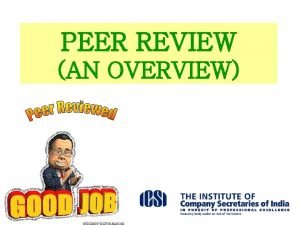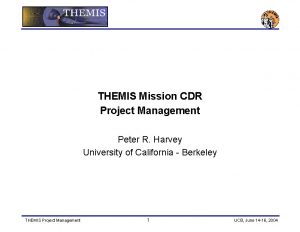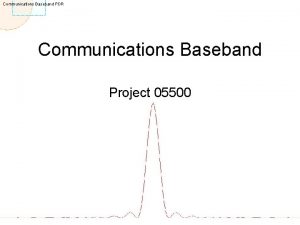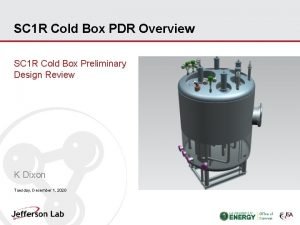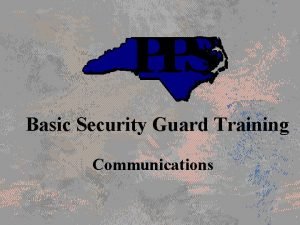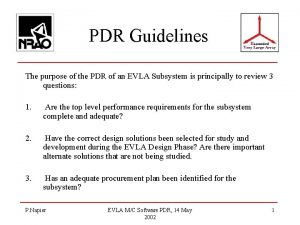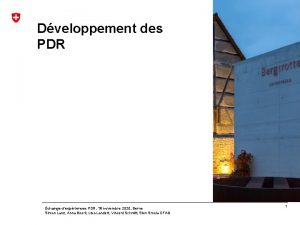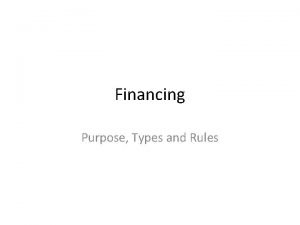PDR 201920 Reviewee Guide Overview The purpose of









- Slides: 9

PDR – 2019/20 Reviewee Guide

Overview The purpose of this guide is to provide you with a complete overview on how to complete your PDR form. Key Dates Review Period (i. e. the period you will be assessed against): 1 June 2019 to 30 June 2020 PDR Form available for completion: July to September 2020 Contents Slide Reviewee Process Guide Slide 3 The Review Meeting Slide 4 Receiving Feedback Slide 5 Objective Setting Slide 6 Objective Setting: Examples Slide 7 Performance Assessment Levels Slide 8 University of Glasgow Values Slide 9 2

Reviewee Guide All Year Review progress against objectives; July to September Checklist: Have you…. Annual Review Completed the performance and development overview section? Launch form in Portal Updated your form with your objectives? Update as necessary Review overall progress against each objective; Add commentary as required and notify your reviewer to complete Meet and discuss progress with reviewer; Receive notification of PDR assessment rating; Discuss and agree objectives for next PDR year. Review reviewer’s comments and final assessment rating Signed off? 3

The Review Meeting The review meeting is a face-to-face two way discussion between reviewee and line manager (reviewer) to: • Review and discuss development including future career aspirations • Review and assess the previous year’s performance; • Discuss areas of excellence and areas for development; • Discuss feedback from other areas; • Set objectives Prior to the meeting you should: • Complete your PDR form with your assessment of your performance, considering the following • Your performance, where have you excelled, where your performance could be improved; • What factors have influence your performance; • Your future development • Next year’s objectives

Receiving Feedback is intended to be constructive in order to enable you to further your development. In order for you to gain from the experience you should: • Listen – to help you understand the validity of what is being said; • Suspend judgment – try not to immediately react defensively, let the reviewer finish to obtain the full picture: you may wish to contemplate what has been said and follow up at a later date; • Paraphrase – summarise what you think has been said to check your understanding; • Prompt specifics – use and ask for specific examples of behaviour; ask open and closed questions to confirm understanding; • Avoid arguing, denying, justifying or minimising – if you believe the information is incorrect you can present contrary evidence; • Consider additional information from other sources – evidence of feedback from others reinforcing and consistent with feedback 5

Objective Setting Further information can be found on our webpages: SMART Objectives Guide Objectives should be SMART • Specific: • Should be sufficiently detailed and precise to be clearly understood by you; • Should not be ambiguous – targets and their importance are clear • Measurable: • Must have a measurable and verifiable outcome to show well the objective has been achieved, this can be through: • Quantity – e. g. completion rates, costs • Quality – e. g. levels of accuracy or a defined measurable standard • Consider how it will be indicated if the objective has been achieved and what mechanisms are required to measure results • Aligned/Achievable: • Should be aligned to the strategic plans and objectives of the Service/School/RI and appropriate for your role and grade; • Should take into account as to the timeframe and resources required to achieve these • Within your capabilities but challenging • Relevant: • Within the remit for your role and grade, yet challenging to in order provide room for development; • Consider the impact if the objective wasn’t achieved in relation to the team/School/Service/College/RI; • Time Bound: • To be delivered within a specific timeframe – sometimes this may be over a period of a few months or even years 6

Objective Setting: Examples Job Family Example Management, Professional & Administrative (MPA) • To effectively and efficiently take the lead on organising the logistics for the annual Staff Administrators Conference scheduled for dd/mm/yy by achieving a score of 4 out of 5 on average from customers on the feedback form. • To review the school’s filing systems and make recommendations for improvements to Line Manager by mm/yy with agreed implementation of recommendations by dd/mm/yy. Operational • Create a comprehensive information pack for all Residencies students as to the services/facilities/clubs available in the SRS as part of their accommodation package by dd/mm/yy. • Provide a catering food offer that delivers “healthy choices” throughout all hospitality outlets to work towards gaining “Healthy Living Award” by end of mm/yy Research & Teaching • To have led publications of xx papers of quality likely to be judged 3* or 4* in the REF in suitable/appropriate journals by dd/mm/yy. • To have written as PI (or co-I), with distinctive contribution) research grant applications of a value exceeding the Russell Group median award value of your discipline and have submitted these by dd/mm/yy. • (Teaching): To complete the preparation of and publish a major undergraduate textbook in X by mm/yy. • Improve student engagement in course A by introducing Y innovation and evidence improvement through improved student feedback and attainment by mm/yy. Technical • To set up a process to inform and update a data base recording the service’s use of substances hazardous to health under COSHH regulations by dd/mm/yy. • Ensure all laboratory equipment in building X passes equipment maintenance testing and produce and up-to-date inventory by dd/mm/yy Performance Standards (Grades 1 -3 only) • Describe the conditions that must exist before the performance can be rated Strong and may be defined for repetitive and routine tasks, for example: • To provide cleaning services to achieve 85% standard in visual quality monitoring; • To ensure all student enquiries are dealt within x days • To ensure mail is delivered to schools by x time each day 7

Performance Assessment Levels Assessment Level Criteria Exceptional Contribution Consistently exceeds expectations relative to role/grade, as evidenced by delivery against objectives to an exceptional standard. In addition, the staff member may have significantly contributed to activities outside the normal scope of their role and/or successfully overcome particular challenges. Strong Contribution Overall performance in the role is strong, demonstrated through strong delivery of objectives and progress against development plans. Performance has been within the normal requirements of the role with some elements above expectations. Inconsistent Performance Overall performance in the role is variable and some key objectives may not have been delivered to the required standard. Expectations are met in some, but not all essential areas of responsibility and further development is required. Improved Performance Required Performance is significantly below expectations of the role. Insufficient progress has been made towards the achievement of objectives and standards and demonstrates areas of repeated inconsistent performance or where significant improvement and/or personal development is required. 8

9
